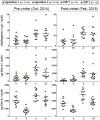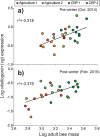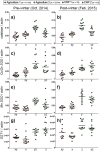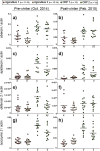Honey bee colony performance and health are enhanced by apiary proximity to US Conservation Reserve Program (CRP) lands
- PMID: 30894619
- PMCID: PMC6426953
- DOI: 10.1038/s41598-019-41281-3
Honey bee colony performance and health are enhanced by apiary proximity to US Conservation Reserve Program (CRP) lands
Abstract
Honey bee colony performance and health are intimately linked to the foraging environment. Recent evidence suggests that the US Conservation Reserve Program (CRP) has a positive impact on environmental suitability for supporting honey bee apiaries. However, relatively little is known about the influence of habitat conservation efforts on honey bee colony health. Identifying specific factors that influence bee health at the colony level incorporates longitudinal monitoring of physiology across diverse environments. Using a pooled-sampling method to overcome individual variation, we monitored colony-level molecular biomarkers during critical pre- and post-winter time points. Major categories of colony health (nutrition, oxidative stress resistance, and immunity) were impacted by apiary site. In general, apiaries within foraging distance of CRP lands showed improved performance and higher gene expression of vitellogenin (vg), a nutritionally regulated protein with central storage and regulatory functions. Mirroring vg levels, gene transcripts encoding antioxidant enzymes and immune-related proteins were typically higher in colonies exposed to CRP environments. Our study highlights the potential of CRP lands to improve pollinator health and the utility of colony-level molecular diagnostics to assess environmental suitability for honey bees.
Conflict of interest statement
The authors declare no competing interests.
Figures





Similar articles
-
Past role and future outlook of the Conservation Reserve Program for supporting honey bees in the Great Plains.Proc Natl Acad Sci U S A. 2018 Jul 17;115(29):7629-7634. doi: 10.1073/pnas.1800057115. Epub 2018 Jul 2. Proc Natl Acad Sci U S A. 2018. PMID: 29967144 Free PMC article.
-
Honey bees overwintering in a southern climate: longitudinal effects of nutrition and queen age on colony-level molecular physiology and performance.Sci Rep. 2018 Jul 11;8(1):10475. doi: 10.1038/s41598-018-28732-z. Sci Rep. 2018. PMID: 29992997 Free PMC article.
-
Effects of different artificial diets on commercial honey bee colony performance, health biomarkers, and gut microbiota.BMC Vet Res. 2022 Jan 21;18(1):52. doi: 10.1186/s12917-022-03151-5. BMC Vet Res. 2022. PMID: 35062935 Free PMC article.
-
Working with State and Provincial Apiary Programs to Manage Honey Bee (Apis mellifera) Health.Vet Clin North Am Food Anim Pract. 2021 Nov;37(3):467-478. doi: 10.1016/j.cvfa.2021.06.003. Vet Clin North Am Food Anim Pract. 2021. PMID: 34689914 Review.
-
Varroa destructor: how does it harm Apis mellifera honey bees and what can be done about it?Emerg Top Life Sci. 2020 Jul 2;4(1):45-57. doi: 10.1042/ETLS20190125. Emerg Top Life Sci. 2020. PMID: 32537655 Free PMC article. Review.
Cited by
-
Cold storage as part of a Varroa management strategy: effects on honey bee colony performance, mite levels and stress biomarkers.Sci Rep. 2023 Jul 22;13(1):11842. doi: 10.1038/s41598-023-39095-5. Sci Rep. 2023. PMID: 37481663 Free PMC article.
-
SDS-PAGE-Based Quantitative Assay of Hemolymph Proteins in Honeybees: Progress and Prospects for Field Application.Int J Mol Sci. 2023 Jun 16;24(12):10216. doi: 10.3390/ijms241210216. Int J Mol Sci. 2023. PMID: 37373362 Free PMC article.
-
Towards Precision Nutrition: A Novel Concept Linking Phytochemicals, Immune Response and Honey Bee Health.Insects. 2019 Nov 12;10(11):401. doi: 10.3390/insects10110401. Insects. 2019. PMID: 31726686 Free PMC article. Review.
-
Improving bee health through genomics.Nat Rev Genet. 2020 May;21(5):277-291. doi: 10.1038/s41576-020-0216-1. Epub 2020 Feb 25. Nat Rev Genet. 2020. PMID: 32099102 Review.
-
Relative impacts of Varroa destructor (Mesostigmata:Varroidae) infestation and pesticide exposure on honey bee colony health and survival in a high-intensity corn and soybean producing region in northern Iowa.J Insect Sci. 2024 May 1;24(3):18. doi: 10.1093/jisesa/ieae054. J Insect Sci. 2024. PMID: 38805656 Free PMC article.
References
-
- Cane, J. H. & Tepedino, V. J. Causes and Extent of Declines among Native North American Invertebrate Pollinators: Detection, Evidence, and Consequences. Conserv. Ecol. 5 (2001).
Publication types
MeSH terms
Substances
LinkOut - more resources
Full Text Sources
Research Materials
Miscellaneous

